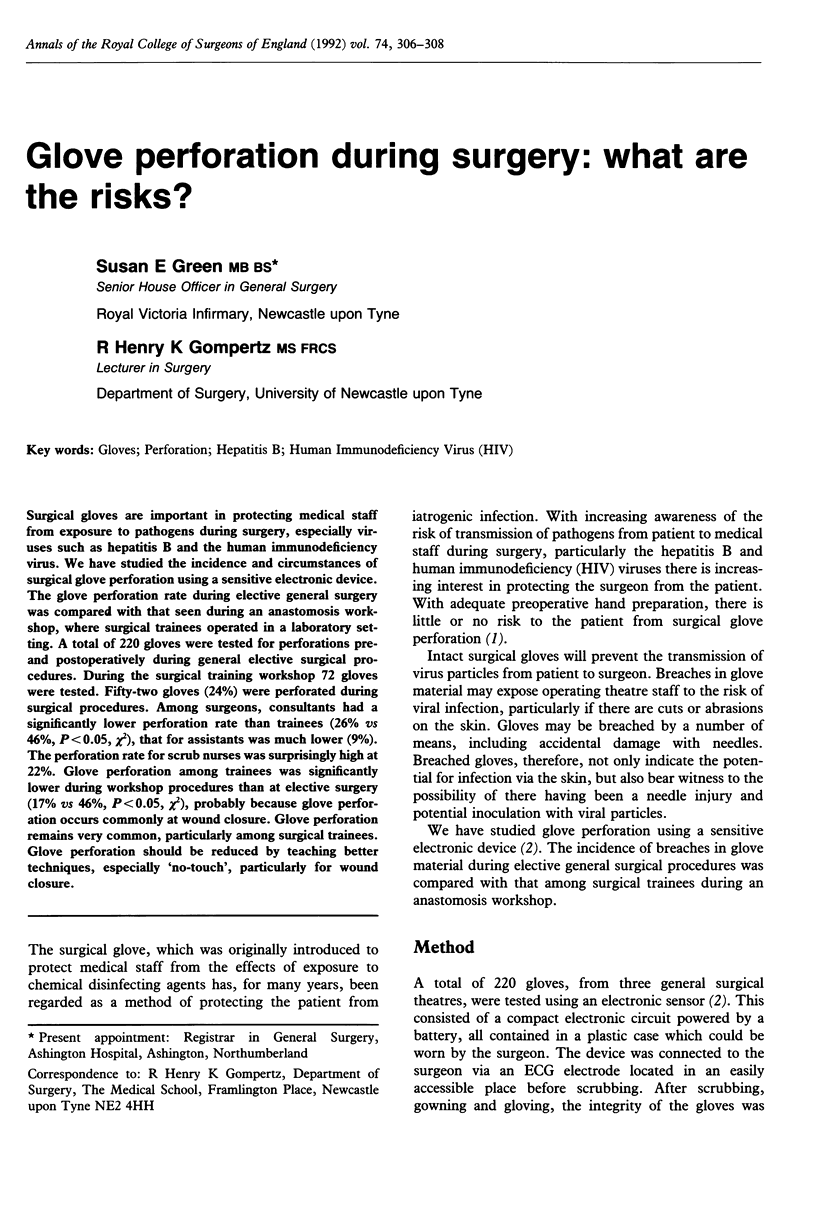Abstract
Surgical gloves are important in protecting medical staff from exposure to pathogens during surgery, especially viruses such as hepatitis B and the human immunodeficiency virus. We have studied the incidence and circumstances of surgical glove perforation using a sensitive electronic device. The glove perforation rate during elective general surgery was compared with that seen during an anastomosis workshop, where surgical trainees operated in a laboratory setting. A total of 220 gloves were tested for perforations pre- and postoperatively during general elective surgical procedures. During the surgical training workshop 72 gloves were tested. Fifty-two gloves (24%) were perforated during surgical procedures. Among surgeons, consultants had a significantly lower perforation rate than trainees (26% vs 46%, P < 0.05, chi 2), that for assistants was much lower (9%). The perforation rate for scrub nurses was surprisingly high at 22%. Glove perforation among trainees was significantly lower during workshop procedures than at elective surgery (17% vs 46%, P < 0.05, chi 2), probably because glove perforation occurs commonly at wound closure. Glove perforation remains very common, particularly among surgical trainees. Glove perforation should be reduced by teaching better techniques, especially 'no-touch', particularly for wound closure.
Full text
PDF


Selected References
These references are in PubMed. This may not be the complete list of references from this article.
- Brough S. J., Hunt T. M., Barrie W. W. Surgical glove perforations. Br J Surg. 1988 Apr;75(4):317–317. doi: 10.1002/bjs.1800750408. [DOI] [PubMed] [Google Scholar]
- Church J., Sanderson P. Surgical glove punctures. J Hosp Infect. 1980 Mar;1(1):84–84. doi: 10.1016/0195-6701(80)90036-5. [DOI] [PubMed] [Google Scholar]
- Dodds R. D., Guy P. J., Peacock A. M., Duffy S. R., Barker S. G., Thomas M. H. Surgical glove perforation. Br J Surg. 1988 Oct;75(10):966–968. doi: 10.1002/bjs.1800751009. [DOI] [PubMed] [Google Scholar]
- Fell M., Hopper W., Williams J., Brennan L., Wilson C., Devlin H. B. Surgical glove failure rate. Ann R Coll Surg Engl. 1989 Jan;71(1):7–10. [PMC free article] [PubMed] [Google Scholar]
- Gerberding J. L., Littell C., Tarkington A., Brown A., Schecter W. P. Risk of exposure of surgical personnel to patients' blood during surgery at San Francisco General Hospital. N Engl J Med. 1990 Jun 21;322(25):1788–1793. doi: 10.1056/NEJM199006213222506. [DOI] [PubMed] [Google Scholar]
- Hamer A. J. Electronic device for the detection of breaches in asepsis during surgical procedures. Br J Surg. 1987 Nov;74(11):1038–1039. doi: 10.1002/bjs.1800741126. [DOI] [PubMed] [Google Scholar]
- Heald R. J. The dog in the night time. Br J Surg. 1991 Jan;78(1):3–5. doi: 10.1002/bjs.1800780103. [DOI] [PubMed] [Google Scholar]


